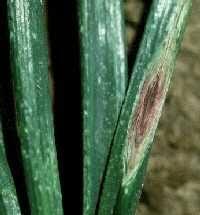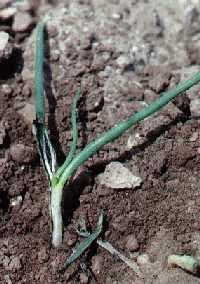Chives Plant
Chives are perennials, 6-12 inches tall, and frost-tolerant. They prefer well-drained, fertile soil in full sun to partial shade. Keep the soil moist. Chives are both edible and have medicinal properties.

Habit
Perennial
Height
20-40 cm
Growth
Moderate
Soil
Well Drained, Loamy
Shade
Full Sun to partial shade
Moisture
Moist
Edible
Yes
Medicinal
Yes
Origin
Europe, Asia
Climatic Condition
Temperate
Temperature (°)
10-25°C
Humidity (%)
50-80%
Potting media
Peat, compost
Fertilizers
NPK 10:10:10
Watering
Regular watering
Plant Weight
300-800 g per fruit
Flowering Time
Spring, Summer
Soil Ph level
5.5 - 7.5
Water Ph level
5.5 - 7.5
Soil EC
1-2 dS/m
Yeild Per Plant
500 g - 1 kg per plant
NPK ratio
10:10:10
life Span
Perennial
Health Benefits
Rich in vitamins A & C, immune booster
Suggested Grow Media or Potting Mix ?
40% compost, 30% peat moss, 30% perlite
Suggested Fertigation/Fertilizers
Fertilize every 2 weeks with a balanced, water-soluble fertilizer.
Common Diseases and Remedies
Botrytis Blight,damping off, downymildew.
Botrytis Blight: This causes the older leaves and the center of the plant to rot. ...
Damping Off: This is one of the most common problems when starting plants from seed. ...
Downy Mildew: Pale spots appear on the leaves with a gray-purple fuzzy growth.
:use good organic potting soil,baking soda.
HEALTH BENEFITS
· High in vitamin K, supporting bone health.
· Contains sulfur compounds that may reduce cancer risk.
· Supports heart health by lowering blood pressure and cholesterol.
What Is An Chives Tree?
Chives (Allium schoenoprasum) are a popular and versatile herb known for their mild onion flavor and narrow, green, hollow leaves. Chives belong to the Allium family, which also includes onions, garlic, and leeks, and are native to Europe, Asia, and North America. These perennial herbs are grown for culinary purposes and add a subtle onion flavor to a variety of dishes. Chives are often used as a fresh garnish to enhance the taste and appearance of salads, soups, and a variety of savory dishes. Beyond their culinary uses, chives are valued for their ornamental properties and are often used in herb gardens or as border plants for their bright green foliage and delicate pink and purple flowers that bloom in late spring to early summer. It is cultivated. Chives are relatively easy to grow and require well-drained soil, sunlight, and regular harvesting to promote continued growth. Chives have become a fixture in kitchens and gardens around the world due to their delicious taste and beautiful appearance.

What Are The Different Types Of Chives Plants?
1. Common chives (Allium schoenoprasum)
This is the standard and best known chive variety. The leaves are thin, cylindrical and hollow, with a mild onion flavor.
2. Chive (Allium tuberosum)
Although technically a separate species, discussions about chives often include chives. The leaves are flat and wide, with a distinctive garlic flavor. Commonly used in Asian cuisine.
3. Grolau Chives (Allium schoenoprasum 'Grolau')
If you are looking for an evergreen areca palm, your search must end here. This This variety is known for its compact growth, making it suitable for container gardening. It has the same mild onion flavor as regular chives.
4. Forestate chives (Allium schoenoprasum "Forescate")
This variety is prized for its vigorous growth and tolerance to low temperatures. It produces attractive pink flowers.
5. Curly Chives (Allium schoenoprasum “Curly”)
As the name suggests, this variety has curly or wavy leaves that add interesting texture to dishes.

How to care for Chives Plants ?
1. Location
Chives (Allium schoenoprasum) are a versatile herb suitable for home cultivation as they can be grown both indoors and outdoors.
Whether indoors or outdoors, chive care requirements are similar, including proper watering, occasional fertilization, and regular harvesting. The choice between indoor and outdoor growing depends on available space, climate, and personal preference. Many gardeners enjoy chives outdoors or in pots on the kitchen windowsill for convenient use in the kitchen.
2. Sunlight
Chives require special lighting conditions to grow and produce high quality yields. Although chives can tolerate some direct sunlight, they prefer partial shade to full sun, with at least 4 to 6 hours of sunlight per day. Too much sunlight can cause your plant to wilt, dry, and eventually die, while too little light can stunt growth and prevent your plant from reaching its full potential. Gardeners can provide ideal lighting conditions by planting chives where they receive morning sun and afternoon shade, or by providing shade to the plant during the hottest part of the day. Masu.
3. Soil
Soil is an important element for plant growth and development. It provides a medium for plant roots to fix and absorb water and nutrients needed for growth. Soil quality can affect plant health and yield. Therefore, it is important to consider the soil to ensure optimal plant growth. Healthy soil should be well-drained and able to hold enough water and nutrients for plants. Well-drained soil drains water and excess nutrients while retaining enough moisture to support plant growth.
4. Hydration
Hydration is essential for plants as it helps maintain the plant's turgor pressure and maintain its shape and structure. Water is also needed for photosynthesis, the process by which plants produce their own energy. If your plants don't get enough water, they can become dehydrated, causing wilted leaves, stunted growth, and even death. On the other hand, if you water too much, diseases such as root rot may occur, or the soil may become waterlogged, leading to nutritional deficiencies.
5. Issues
Chives are versatile herbs that can grow in a variety of soils, but they require proper nutrition to grow and produce healthy yields. Chives prefer fertile, well-drained soil rich in organic matter. Gardeners can improve the soil by mixing in compost and other organic matter before planting to ensure sufficient nutrients for plant growth. Chives benefit from regular fertilization during the growing season with a balanced fertilizer containing nitrogen, phosphorus, and potassium at an NPK ratio of 10-10-10 or 12-12-12. Although these are hardy herbs, you may face certain problems. Affects growth and health. A common problem is overwatering, which causes soggy soil and root rot. It is important to keep the soil well-drained and allow the topsoil to dry between waterings. Additionally, chives can be susceptible to pests such as aphids and thrips, which can attack the leaves and reduce plant vigor.

What are the Benefits of Chives Plants ?
Chives (Allium schoenoprasum) offer many health benefits as they are not only a delicious addition to cooking, but also a valuable herb in terms of nutritional content. Chives are rich in vitamins, especially vitamin A and vitamin C, which support the immune system and skin health. Antioxidant properties from compounds such as quercetin and allicin may fight oxidative stress in the body and reduce the risk of chronic disease. Chives also contain important minerals such as iron and calcium. Plus, it's low in calories and high in fiber, which promotes digestive health. Beyond their nutritional profile, chives also have antibacterial properties that can contribute to your overall health. Chives, a member of the Allium family that includes garlic and onions, are associated with potential cardiovascular benefits and may help control cholesterol levels. With their bright green color, mild onion flavor, and a host of health-promoting compounds, chives are a delicious herb that not only enhances the flavor of your dishes, but also adds nutritional value to a balanced diet.

FAQs About Growing Chives
1. How do I use chives in my cooking?
Chives are versatile and can be used raw or lightly cooked. It is often used as a garnish for soups, salads, and various dishes. Chopped chives add a mild onion flavor to recipes.
2. Is chive a perennial?
Yes, chives are perennials. That is, they can survive for several years. It often dies in the winter, but regrows in the spring.
3. Can I grow chives from seeds?
Yes, chives can be grown from seeds. You can sow the seeds directly in your garden, or you can plant them indoors and transplant them once the seedlings have taken root.
4. Can I freeze chives?
Yes, you can freeze chives for later use. Wash and chop before freezing to preserve flavor when using in prepared dishes.
5. Are chives and green onions the same?
Chives and alliums are closely related, but they are different plants. Chives have thin, hollow leaves and a mild flavor, while rakkyo has a strong flavor and thick stems.

